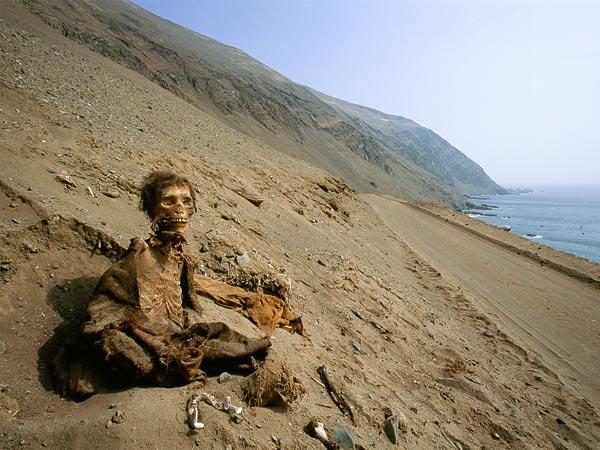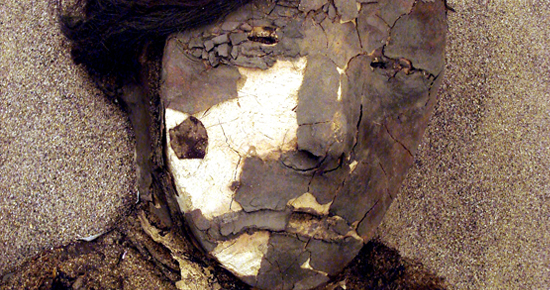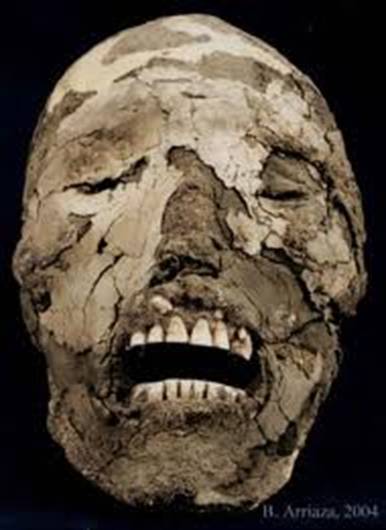This entry was posted on lunes, octubre 8th, 2012 at 18:19 and is filed under Etnopaisaje. You can follow any responses to this entry through the RSS 2.0 feed. You can leave a response, or trackback from your own site.

Las antiguas momias Chinchorro en las arenas del desierto de Chile.The Chinchorro mummies in ancient desert sands of Chile
……..
Las antiguas momias Chinchorro en las arenas del desierto de Chile
…..
…….
The Chinchorro mummies in ancient desert sands of Chile
….
….
Etnopaisaje.com
..
..
.
.
…..
Paisaje de cadáveres pudo haber inspirado las primeras momias
…
……
Landscape of corpses may have inspired the first mummies
…………
..Etnopaisaje.com
………
Hace 7000 años, en la quietud del desierto del norte de Chile y con la brisa constante del mar, un pueblo de personas que hoy conocemos como cultura Chinchorro, emprendió un trabajo fascinante: la preservación de sus muertos. Dos mil años antes que los egipcios, estos antepasados elaboraban las primeras momias artificiales del mundo.
…….
……..

………………..
Para realizar este especializado trabajo, los Chinchorro crearon varias técnicas con las cuales confeccionaron momias clasificadas en 3 tipos: Negras, Rojas y con Vendas. En el patio de sus pequeñas viviendas, construidas de palos y cubiertas de pieles de animales marinos, tenían todos los implementos usados por los expertos y aprendices que practicaban estas técnicas mortuorias: arcillas, fibras, cuchillos, pinturas, cuerdas y agua.
…..
…
¿Cómo hacían las momias?
……
………
Para cada tipo de momia existía una técnica y terminaciones especiales. Las negras (5.000 a.c.) eran las más complejas, ya que los cuerpos se reconstruían como estatuas. Una vez limpio el cuerpo y esqueleto, se creaba un armazón o estructura interna muy rígida con huesos, palos y juncos, amarrados con cuerdas de fibra vegetal, reforzando la estructura al nivel de las rodillas, codos y tobillos. Luego, el preparador fúnebre moldeaba arcilla gris en todo el cuerpo, recuperando parte del volumen corporal perdido.
…….
…..
Con una pasta negra (óxido de manganeso), utilizando brochas de fibra vegetal, pintaban externamente todo el cuerpo con una delgada capa. Después, los preparadores fúnebres creaban una peluca con manojos cortos de cabello, atándolo en unos de sus extremos. Para modelar las características máscaras de las Momias Chinchorro, marcaban los ojos con un delgado palito, mientras que la nariz y la boca se señalaban con pequeños orificios. Posiblemente, creían que las momias contenían el espíritu del difunto, ya que las pintaban con los ojos y la boca abierta proyectando vida.
……..
………
Las momias rojas (2.000 a.c.) eran un poco más sencillas que las negras y el cuerpo se intervenía menos, ya que hacían cortes a nivel del estómago y removían los órganos, aunque también se reforzaba la estructura con maderos, como en el caso de las momias negras.
……
…..
Esta exposición constante a las momias naturales pueden haber dado lugar a un culto a los muertos que implica la momificación artificial.
……
……
7000 Years ago, in the stillness of the desert of northern Chile and with the constant breeze from the sea, a village of people that we know today as Chinchorro culture, undertook a fascinating: the preservation of their dead. Two thousand years before the Egyptians, these ancestors elaborated the first mummies of the artificial world.
…….
…..
To perform this specialized work, the Chinchorro created several techniques with which drew up mummies classified into 3 types: black, red and bandages. On the patio of their small houses, built of sticks and covered with marine animal skins, were all used by experts and apprentices who practiced these techniques mortuary: clays, fibers, knives, paint, rope and water.
….
……
How did the mummies?
……
……
For each type of mummy was a technique and special finishes. Black (5,000 ac) were the most complex, as the bodies were reconstructed as statues. After cleaning the body and skeleton, is creating a frame or very rigid internal structure with bones, sticks and reeds, tied with ropes of vegetable fiber, reinforcing the structure at the knees, elbows and ankles.
……..
…….
Then, the preparer funeral molded gray clay throughout the body, recovering part of the body volume lost
´´´´´´´
´´´´´´´
.
With a black paste (manganese oxide), using plant fiber brushes, externally painted all over with a thin layer. Then preparers funeral created a wig with short tufts of hair, tying it at one of its ends. To model the characteristics Chinchorro Mummies masks, eye marked with a thin stick, while the nose and mouth were marked with small holes. Possibly the mummies believed contained the spirit of the deceased, as painted with eyes and mouth open projecting life.
……..
…..
Red Mummies (2,000 ac) were a bit simpler than the black and the body intervened less, and that made cuts to the stomach and were removing the organs, but also reinforced the structure with wood, as in the case of black mummies.
….
…….
This constant exposure to natural mummies may have led to a death cult involving artificial mummification.
…..
…….

………….

…………